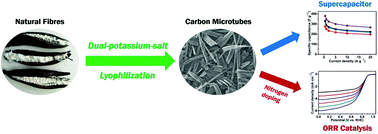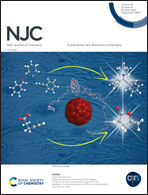Dual potassium salt-assisted lyophilization of natural fibres for the high-yield synthesis of one-dimensional carbon microtubes for supercapacitors and the oxygen reduction reaction†
Abstract
One-dimensional kapok fibre-derived carbon microtubes (KCMT) were synthesized via the dual potassium salt-assisted lyophilization of biochar. The optimal KCMT not only possessed a well-developed porous, microtubular architecture with a large specific surface area, but also presented a high production yield (55.3%) owing to the moderate effect of the molten potassium salts. The optimum material exhibited excellent capacitive performances, including a high mass specific capacitance (380.1 F g−1 in alkaline electrolyte), high energy density (25.0 W h kg−1 in neutral electrolyte) and good cycling stability (capacitance retention of 90.1% after 8000 cycles). This synthetic strategy can also be extended to the preparation of analogous CMT made from other natural fibres, as exemplified by the use of poplar catkin and cotton wool. Further, the metal-free carbon-based electrocatalyst obtained via the post-nitrogen doping of KCMT exhibited high catalytic activity towards the oxygen reduction reaction (ORR). Our synthetic approach demonstrates good potential for the synthesis of microtubular carbon-based materials for application in electrochemical energy-related technology.



 Please wait while we load your content...
Please wait while we load your content...